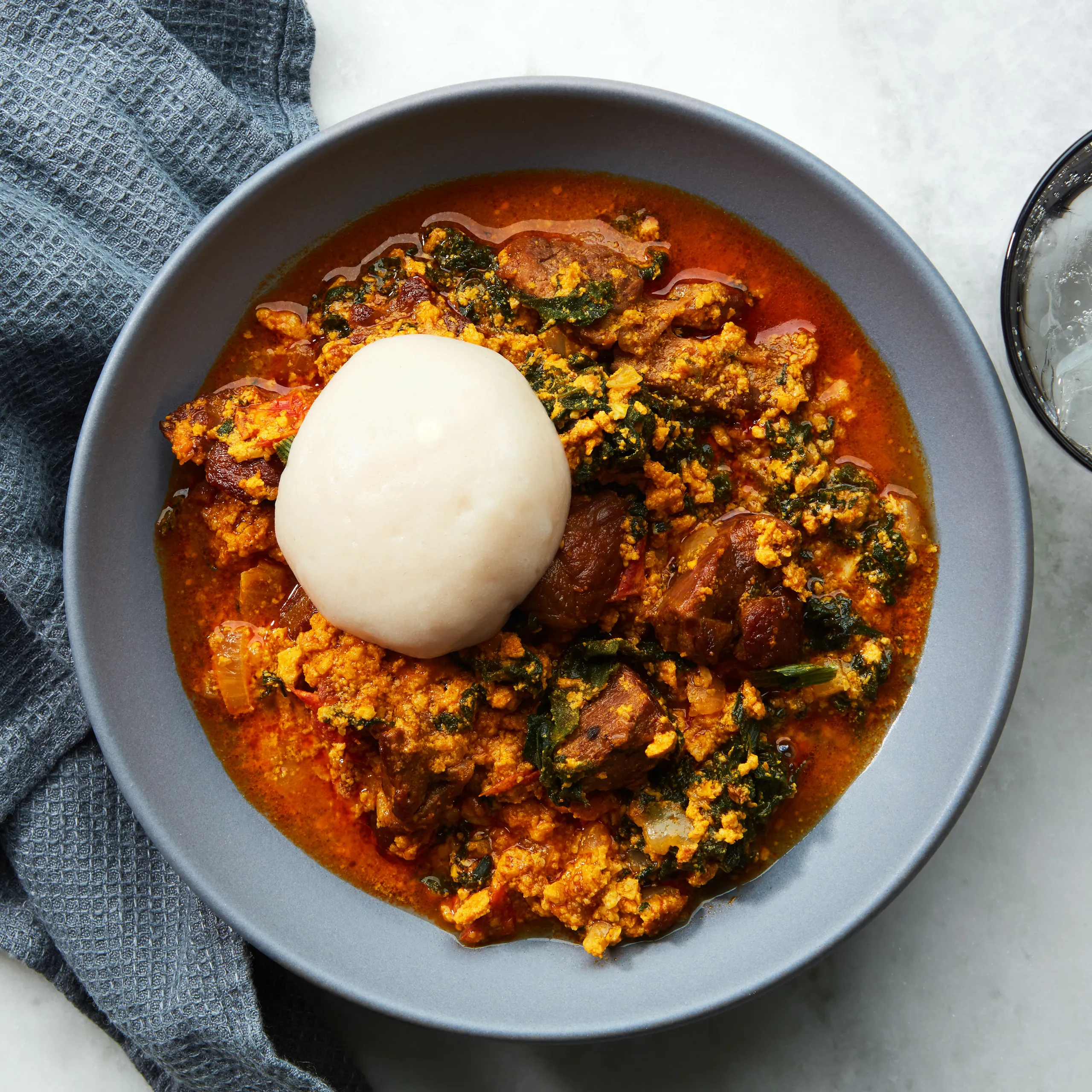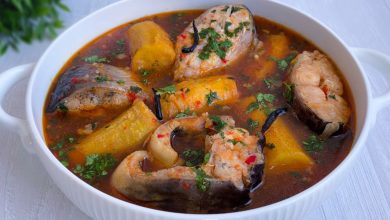Introduction
Fufu and Egusi Soup stand as pillars of Nigerian cuisine. This dish combines the smooth, starchy fufu—made from cassava or plantain—with the rich, nutty flavor of egusi soup prepared from ground melon seeds. Whether enjoyed at family gatherings or as a comforting meal on a busy weekday, this recipe offers an authentic taste of Nigeria. Its blend of tender meat, savory spices, and vibrant vegetables creates an unforgettable dining experience that tells a story of tradition, culture, and culinary passion.
Time
- Preparation Time: 40–50 minutes
- Cooking Time: 1–1.5 hours
- Total Time: Approximately 2 hours
Need Equipments
- Large pot (for boiling meat and fufu)
- Frying pan or skillet (for frying the egusi paste)
- Mortar and pestle or fufu machine (if preparing fufu from scratch)
- Stirring spoon
- Cutting board and sharp knife
- Measuring cups and spoons
- Blender or food processor (optional, for a smoother egusi paste)
Tags
Traditional Nigerian, West African, Comfort Food, Hearty Meal, Authentic Cuisine, Family Recipe
Serving Size
- Standard Serving: Serves 4–6 people
- Portion Suggestion: 1–2 fufu balls per serving accompanied by a generous ladle of egusi soup
Difficulty Level
- Moderate: While the recipe includes multiple components, following the step-by-step instructions ensures a delicious outcome.
Allergen Information
- Potential Allergens:
- Palm oil (may trigger sensitivities in some individuals)
- Meat proteins (various animal allergens)
- Crayfish (shellfish allergen, if included)
- Gluten-Free: Yes (when using naturally gluten-free ingredients like cassava/plantain and egusi seeds)
Dietary Preference
- Primary: Non-Vegetarian (due to meat)
- Adaptable: Can be modified to suit pescatarian or vegetarian diets by substituting meat with fish or legumes and using vegetable broth
Course
- Main Course: Ideal for a hearty lunch or dinner
Cuisine
- Nigerian / West African Cuisine
Ingredients
For Fufu
| Ingredient | Quantity | Notes |
|---|---|---|
| Fufu flour or fresh cassava/plantain | 2–3 cups (or equivalent in fresh ingredients) | Pre-made fufu flour or freshly prepared from boiled cassava/plantain |
| Water | As needed | For boiling and achieving desired consistency |
For Egusi Soup
| Ingredient | Quantity | Notes |
|---|---|---|
| Ground egusi seeds | 1–2 cups | Toasted and ground melon seeds |
| Meat (goat, beef, or chicken) | 500g | Cut into bite-sized pieces; can be substituted with fish or additional proteins for variety |
| Palm oil | 2–3 tablespoons | For frying the egusi paste |
| Onions | 1 medium (finely chopped) | Enhances the aromatic base |
| Tomatoes | 2 medium (chopped) | Adds a tangy sweetness and color to the soup |
| Ground pepper (optional) | 1–2 teaspoons | Adjust according to your spice tolerance |
| Ground crayfish (optional) | 1 tablespoon | For an extra layer of savory flavor; omit if allergic |
| Spinach or bitter leaf | 1–2 cups | Fresh or frozen; offers vibrant greens and nutrients |
| Seasoning cubes or powder | 2–3 cubes | Adjust to taste |
| Salt | To taste | Enhance and balance the flavors |
| Water | As needed | For boiling meat and adjusting soup consistency |
Instructions
Step 1: Preparing the Fufu
- Using Fresh Ingredients:
- Peel and cut cassava or plantains into chunks.
- Boil in a large pot for 20–30 minutes until tender.
- Drain and pound in a mortar and pestle (or use a fufu machine) until smooth and stretchy. Use warm water sparingly if needed.
- Using Fufu Flour:
- Bring 2–3 cups of water to a boil.
- Gradually stir in the fufu flour, ensuring no lumps form.
- Stir continuously until the mixture thickens into a smooth, stretchy consistency. Cover and cook for an additional 5–10 minutes before serving.
Step 2: Preparing the Egusi Soup
- Cooking the Meat:
- Place meat in a large pot and cover with water.
- Season with salt and seasoning cubes. Bring to a boil and simmer for 30–40 minutes or until tender.
- Remove the meat and reserve the broth for the soup.
- Frying the Egusi Paste:
- In a frying pan, heat the palm oil over medium heat.
- Add chopped onions and fry until translucent.
- Stir in ground egusi seeds and fry for 5–7 minutes until fragrant and slightly golden.
- Add chopped tomatoes; continue cooking for an additional 5 minutes.
- Bringing it Together:
- Transfer the fried egusi paste into the pot with the meat stock (or add water as needed) and mix thoroughly.
- Allow the mixture to simmer for 15–20 minutes to develop a thick, rich paste.
- Return the cooked meat to the pot and incorporate additional seasoning cubes, ground pepper, and ground crayfish if using.
- Add spinach or bitter leaf and cook for another 10 minutes, letting all flavors meld.
- Adjust consistency by adding extra stock or water, and season with salt to taste.
Step 3: Serving the Dish
- Plate and Enjoy:
- Scoop the fufu onto plates, forming smooth balls.
- Ladle the egusi soup generously over or alongside the fufu.
- Serve hot with a side of your favorite accompaniments.
Preparation Tips
- Ingredient Freshness: Use fresh meat and greens for optimal flavor.
- Consistent Texture: For smooth fufu, be sure to pound or stir continuously to avoid lumps.
- Toasting Egusi: Lightly toasting the egusi seeds before grinding enhances the nutty flavor.
- Broth Retention: Save the meat broth as it adds a depth of flavor to the soup.
Nutritional Information
| Nutrient | Amount Per Serving | % Daily Value |
|---|---|---|
| Calories | 400–500 kcal | 20–25% |
| Protein | 25–30 g | 50–60% |
| Carbohydrates | 50–60 g | 15–20% |
| Fiber | 5–6 g | 20% |
| Fat | 15–20 g | 25–30% |
| Sodium | 400–500 mg | 20–25% |
| Calcium | 100–150 mg | 10–12% |
| Iron | 2–3 mg | 10–12% |
Tips and Tricks
- Enhancing Flavor: Experiment with additional spices such as smoked paprika or bay leaves in the meat broth.
- Texture Variation: Some like a chunkier soup; you can add extra diced tomatoes or vegetables towards the end of cooking.
- Timing is Key: Simmer the soup slowly to allow the flavors to meld perfectly.
Add-ons
- Protein Variations: Consider adding boiled eggs or tofu for an alternative protein boost.
- Vegetable Boost: Enhance the nutritional value by incorporating extra vegetables like okra or carrots.
- Herbs: A sprinkle of fresh basil or parsley can add an unexpected but delightful twist.
Side Dishes
- Salad: A fresh cucumber-tomato salad provides a cool contrast to the warm, spicy soup.
- Pounded Yam: In addition to fufu, pounded yam is a popular side that complements egusi soup.
- Rice: A small portion of steamed rice can balance the intense flavors of the soup.
Improvements
- Modern Twists: Try blending part of the soup for a creamier texture while keeping some chunks for contrast.
- Healthier Options: Substitute some of the meat with leaner cuts or plant-based proteins for a lighter version.
- Cooking Methods: Use a slow cooker for the meat to enhance tenderness and infuse richer flavors into the broth.
Save and Store
- Refrigeration: Store leftover egusi soup in an airtight container in the refrigerator for up to 3 days.
- Freezing: Freeze in portions for up to 1 month. Reheat gently on the stovetop, adding a splash of water or broth to restore consistency.
- Fufu Storage: Fufu is best served fresh. If needed, reheat by steaming or gently microwaving with a damp cloth covering to retain moisture.
FAQ
Q1: Can I make this dish vegetarian?
A: Yes. Replace the meat with tofu, mushrooms, or a mix of hearty legumes. Use vegetable broth in place of meat stock.
Q2: What can I use if I don’t have fufu flour?
A: You can make fufu from boiled cassava or plantains by pounding them until smooth. Alternatively, some African grocery stores sell ready-to-eat fufu.
Q3: How do I adjust the spice level?
A: The dish is naturally mild to medium. Increase the ground pepper or add a dash of chili oil if you prefer a spicier meal.
Q4: Can I prepare egusi soup in advance?
A: Absolutely. Egusi soup tastes even better after a day as the flavors meld. Just store it in the refrigerator and reheat gently.
Q5: Is fufu gluten-free?
A: Yes, traditional fufu made from cassava or plantain is gluten-free. Always check the packaging of fufu flour for any additives if you have gluten sensitivity.
Conclusion
Fufu and Egusi Soup is more than just a dish—it’s a cultural journey into the heart of Nigerian cuisine. This recipe, filled with rich flavors and textures, is accessible enough for everyday cooking yet holds a deep heritage that resonates with tradition. Whether you’re a seasoned chef or a culinary explorer, preparing this meal is an opportunity to connect with the authentic tastes of Nigeria. Enjoy the process, experiment with the flavors, and most importantly, savor every bite of this exquisite delicacy.
References
- Traditional Nigerian cookbooks and culinary guides
- Online food blogs dedicated to West African recipes
- Nutritional data derived from standard food databases and recipe analyses
This comprehensive guide provides you with everything you need to create a memorable Fufu and Egusi Soup experience. Enjoy your cooking journey and the delightful meal that awaits!





